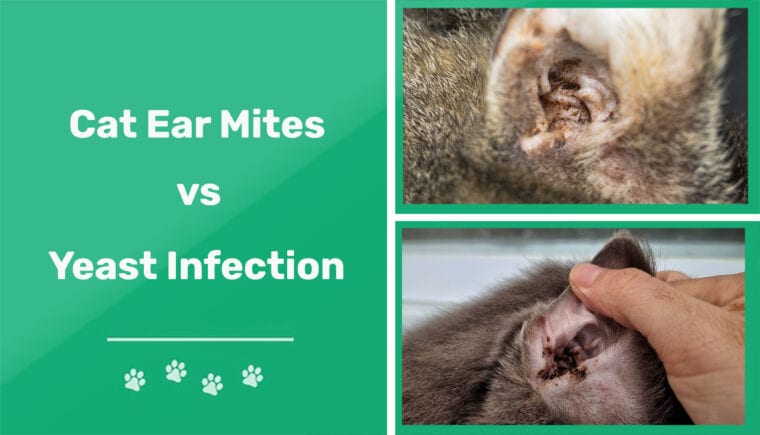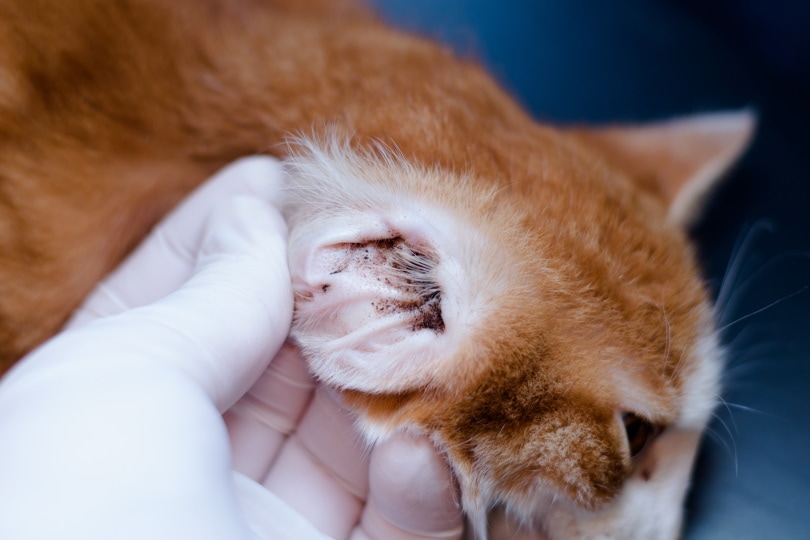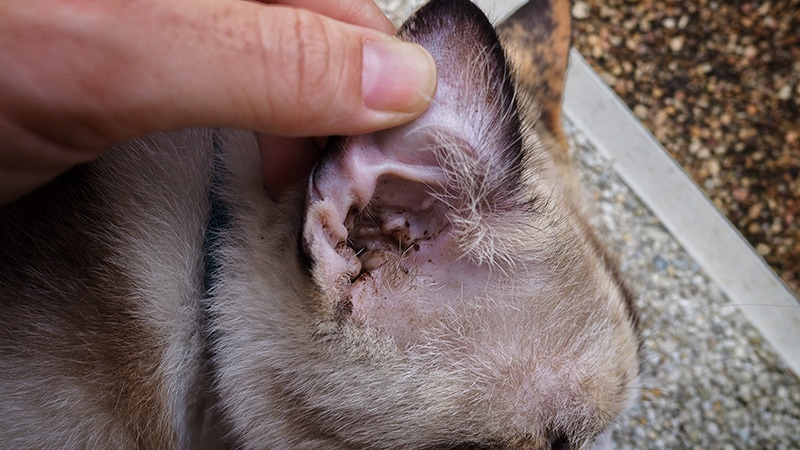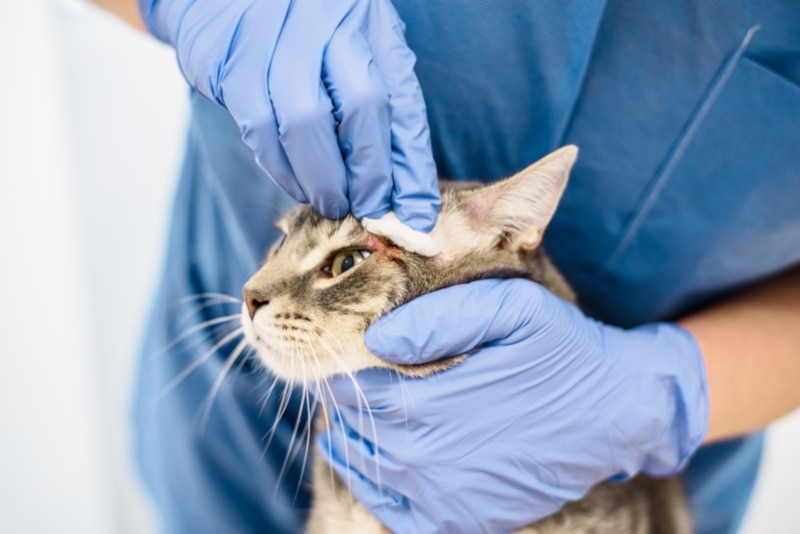
Click to Skip Ahead
Cats sometimes develop ear infections, and when they do, it’s often hard to determine precisely what’s causing the issue. Ear mites are commonly implicated in outer ear infections (Otitis externa). Yeast infections are usually secondary infections that pop up when there’s already another condition irritating the sensitive tissue inside the cat’s ear canal.
Ear mite infestations, when left untreated, can allow the development of yeast and bacterial infections in cats to take hold, as can conditions that consistently irritate cats’ ears, such as allergies. Cats can develop yeast infections in their outer, middle, and inner ears. While ear mite infestations and yeast infections share many signs and can be difficult to tell apart, there are distinct differences between their causes and how each is diagnosed and treated.
Visual Differences

At a Glance
Overview of Ear Mites

Ear mites are one of the most common causes of outer ear infections among cats. Signs of the condition include scratching and head shaking. It’s also pretty common to see a dark brown discharge in affected cats’ ears. This is sometimes described as having a “coffee ground” appearance.
Ear mites are technically called Otodectes cynotis, and they’re parasites that can live on the skin of animals. They’re generally found in the outer portion of a cat’s ear canal. They are relatively easy for veterinarians to diagnose but are not very visible to the naked eye. They’re highly contagious and are often passed from pet to pet through direct contact.
Ear mites sometimes look like white dots crawling on the surface of the ear discharge. They have relatively short life cycles, and adults live for about 2 months. They’re most commonly seen in kittens, but adult cats that regularly go outdoors or come into contact with pets who do can also end up with the parasites.
Diagnosis and Treatment
Veterinarians often rely on information provided by pet parents to get started with diagnosing ear infections. They will also carefully examine your cat’s ears and look at any discharge under a microscope to get an accurate idea of what’s going on.
The treatment is usually relatively straightforward, particularly if the condition is caught early enough and no secondary infections have developed; it often involves topical treatments of anti-parasite medication and sometimes an injection or a course of tablets to help with the itchiness and associated pain. Cats generally get better in a week to 10 days, depending on how bad the secondary infection is. Getting rid of the mites is often enough to get cats back to feeling significantly better. Reinfestation after treatment commonly occurs so treating all pets in the home that can be infested with ear mites is vital.
Overview of Yeast Infections

Yeast infections are usually secondary infections that start when cats already have something else going on with their ears. Cats can develop yeast infections in one ear, or both can be affected simultaneously, and they can show up in a cat’s outer, middle, and inner ears.
Signs of yeast infections include red and inflamed skin around the ear and the presence of a dark discharge. There’s often a distinct, slightly sweet odor as well. Yeast infections that start in the outer ear and aren’t promptly treated can lead to inflammation and further infections in the middle and inner parts of the ear, which can cause cats to have problems with balance and coordination.
Just about anything that consistently irritates cats’ ears predisposes the ear canal to a yeast and/or bacterial infection, as the scratching and inflammation caused by the underlying condition often creates an environment that is just right for yeast to thrive.
Cats that develop itchy skin and ears from allergic conditions frequently also end up with yeast infections due to their compromised skin barrier and an increased production of wax. Allergies are often related to food and environmental sensitivities. Other conditions that can cause skin irritation that can lead to the development of yeast infections in the ears include tumors, polyps, and endocrine and immune disorders.
Diagnosis and Treatment
Diagnosis is usually based on a physical exam and information about the cat’s condition. Microscopic analysis is used to determine whether an infection is due to bacteria, fungi, or parasite. If an overgrowth of yeast is diagnosed, initial treatment usually involves antifungal and anti-inflammatory medication.
Figuring out what’s causing the irritation is vital to getting cats back to normal. Feline allergies, a common cause of itchy skin, are generally best addressed by trigger identification and avoidance. Surgical intervention is sometimes required to deal with tumors and polyps causing the irritation.
Regular ear cleaning is usually required to help move things along. Cat’s ears can be damaged by aggressive cleaning and harsh chemicals (like hydrogen peroxide and alcohol), so follow your veterinarian’s instructions when keeping your buddy’s ears clean, and always clear any product you intend to put in your cat’s ear with your veterinarian before use.
Can Ear Infections Be Prevented?

While almost no health condition can be totally prevented, there are methods that can reduce the chances of cats getting ear infections. Keeping cats indoors is one of the easiest ways to encourage parasites like mites to stay away, as cats pick them up after coming into contact with infected animals.
Regularly using anti-parasite medications that are effective against mites as well as fleas and other pests can lower the chance of the problem returning. Always consult your veterinarian before giving your cat any flea, mite, or other anti-parasite treatment, including over-the-counter products, to ensure the product is safe and appropriate for your pet’s needs. Remember that anti-parasite products made for dogs should never be used on cats since they often contain a chemical (permethrin) that’s highly toxic to cats.
Checking your cat’s ears to make sure they’re healthy can go a long way toward ensuring problems are caught and addressed early. Healthy ears should be light pink inside and free of wax and odors.
Cats generally don’t need help cleaning their ears when everything is working as it should. Staying on top of underlying conditions that can cause itchy ears, such as allergies, fleas and other immune disorders may also reduce the number of times cats contract ear infections.
What’s the Difference Between Inner and Middle Ear Infections
Cats have three sections to their ear canal; inner, middle, and outer. The eardrum divides the outer ear from the middle and inner parts. Cats can develop infections in all parts of their ear canals. Middle and inner ear infections tend to be much more severe than outer ear problems and they can be more difficult to treat.

Outer Ear Infections (Otitis externa)
Outer ear infections occur more frequently than inner and middle ear issues. Mites and allergies can cause outer ear problems, but if the itchiness isn’t addressed, middle and ultimately inner ear infections can develop. Outer ear yeast and bacterial infections typically occur after the ears become itchy and inflamed due to another (primary) cause.
Middle Ear Infections (Otitis media)
Cats can develop middle ear infections if their eardrums become perforated either due to trauma, nasty outer ear infections, or the development of a tumor/polyp within the canal. Infections can move from the outer to the middle and inner ears. Signs of middle ear conditions often include scratching, head tilting, redness, and inflammation.
In more serious cases, a cat’s facial nerve can become affected, which can result in drooping eyelids. Untreated middle ear infections can progress to inner ear problems.
Inner Ear Infections (Otitis interna)
Bacteria are the most common culprit when it comes to inner ear infections, but yeast can also lead to problems. Inner ear infections can cause cats to have difficulty with balance and coordination. Some tilt their heads on the affected side.
Inner ear problems can spread to the brain and create neurological signs. This is a very rare but serious complication. Untreated inner ear infections can permanently impact a cat’s balance and hearing. Severe inner ear infections often require imaging (usually a CT exam) and extensive antibiotic treatment to prevent the issue from returning..
Conclusion
When cats get ear infections, it can be hard to pin down the primary cause since many ear conditions share similar signs, such as head shaking, scratching, and discharge from the ear. Ear mites are one of the most common causes of ear infections, particularly in kittens. Ear mite infestations irritate the cat’s ears, which often causes them to scratch to the point they develop secondary problems such as bacterial or yeast infections. Common signs of yeast infections include head shaking, scratching, red, inflamed skin, and the presence of an odor.
Featured Image Credit: (T) Todorean-Gabriel, Shutterstock | (B) RJ22, Shutterstock







